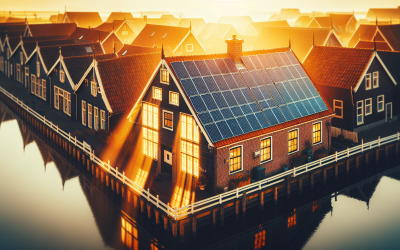So, you’re curious about powering your entire home or business with solar energy? It’s a great question, and one that many people are asking these days. With increasing concerns about the environment and rising energy costs, solar power is becoming an attractive option for homeowners and businesses alike. In this article, we’ll take a closer look at the potential of solar energy to meet all of your power needs, exploring the benefits, considerations, and potential drawbacks of going solar. Get ready to discover if solar power is the right choice for you!
Benefits of Solar Energy
Environmentally Friendly
Solar energy is a sustainable and environmentally friendly source of power. Unlike traditional methods of electricity generation, such as coal or natural gas, solar energy produces no harmful emissions or pollutants. This means that using solar power reduces your carbon footprint and helps combat climate change. By utilizing the sun’s energy, you can contribute to a cleaner and greener world for future generations.
Renewable and Sustainable
One of the key advantages of solar energy is that it is a renewable and sustainable resource. The sun provides an abundant supply of energy that will never run out. As long as the sun continues to shine, you can harness its power and convert it into electricity. Unlike fossil fuels, which are finite and will eventually be depleted, solar energy offers a long-term solution to our energy needs. By investing in solar power, you are embracing a sustainable lifestyle and promoting a more secure energy future.
Reduces Electricity Costs
One of the most appealing aspects of solar energy is its potential to significantly reduce your electricity costs. By generating your own electricity through solar panels, you can offset the amount of energy you need to purchase from the grid. This means lower monthly bills and potential long-term savings. Additionally, many regions offer incentives and net metering programs that allow you to sell excess energy back to the grid, further reducing your overall energy expenses. With solar power, you can take control of your energy costs and enjoy the financial benefits it brings.
Understanding Solar Power
How Solar Panels Work
Solar panels work by harnessing the power of the sun’s rays and converting it into electricity. The panels are made up of photovoltaic (PV) cells, which are composed of semiconductors such as silicon. When sunlight hits these cells, it excites the electrons within them, generating a flow of electrical current. This direct current (DC) is then converted into alternating current (AC) through an inverter, which is suitable for use in our homes and businesses.
Types of Solar Systems
There are primarily two types of solar power systems: grid-tied and off-grid systems.
Grid-tied systems are connected to the local electrical grid. They allow you to use the electricity generated by your solar panels while also drawing power from the grid when needed. This type of system eliminates the need for costly battery storage and provides a reliable source of electricity.
On the other hand, off-grid systems are not connected to the grid. They require the use of batteries to store surplus energy that can be used during periods when the sun is not shining. Off-grid systems are commonly used in remote areas where access to the grid is limited or nonexistent.
Factors Affecting Solar Energy Production
Several factors can affect the production of solar energy, including geographic location, orientation and tilt of the solar panels, shading, and weather conditions. Regions with abundant sunshine and minimal cloud cover are more conducive to maximizing solar energy production. It is important to consider these factors when designing and installing a solar power system to ensure optimal performance and efficiency.
Sizing your Solar Energy System
Energy Consumption Assessment
Before installing a solar energy system, it is crucial to assess your energy consumption accurately. This involves analyzing your past electricity bills to determine your average daily and monthly usage. By understanding how much energy you consume, you can determine the capacity and size of the solar system required to meet your needs effectively.
Determining Solar Panel Capacity
Once you have assessed your energy consumption, the next step is to determine the capacity of your solar panels. This is influenced by factors such as the available roof space, the efficiency of the panels, and your energy goals. By choosing the right capacity, you can generate enough electricity to meet your energy demands while optimizing your investment in solar energy.
Battery Storage Considerations
While grid-tied systems do not require battery storage, off-grid systems rely on batteries to store excess energy. When sizing your solar energy system, it is important to factor in the capacity of the batteries and their ability to store enough energy to meet your needs during periods when the sun is not shining. Additionally, consideration must be given to maintenance and replacement costs of the batteries over the life of the system.
Equipping your Home/Business with Solar Energy
Choosing the Right Solar Panels
When equipping your home or business with solar energy, it is essential to choose the right solar panels. There are several types of solar panels available, including monocrystalline, polycrystalline, and thin-film panels. Each type has its advantages and disadvantages, so it is important to consider factors such as efficiency, space availability, and budget when making your selection. Consulting with a reputable solar installer can help guide you in selecting the best panels for your specific needs.
Inverter Selection
Inverters play a crucial role in a solar energy system by converting the direct current (DC) generated by the solar panels into usable alternating current (AC) for your home or business. There are different types of inverters available, such as string inverters, microinverters, and power optimizers. Each type has its unique advantages and may be suitable for different applications. Working with a knowledgeable solar professional can help you make an informed decision when selecting an inverter for your system.
Optimizing System Performance
To maximize the performance of your solar energy system, it is important to optimize various aspects. This includes the orientation and tilt angle of the solar panels, taking into account the sun’s path throughout the day and year. Additionally, regular maintenance and cleaning of the panels are essential to ensure optimal efficiency. Monitoring your system’s performance and addressing any issues promptly will also help maintain its productivity and longevity.
Grid Connection and Net Metering
If you opt for a grid-tied solar energy system, it is important to understand the process of grid connection and net metering. Grid connection involves the installation of a bi-directional meter that allows you to both draw energy from the grid and export excess energy back to the grid. Net metering allows you to receive credits for the surplus energy you generate, which can offset your future electricity bills. Understanding the regulations and policies regarding grid connection and net metering in your region is important to ensure a smooth transition to solar energy.
Financing and Incentives
Solar Energy Financing Options
Investing in solar energy may require significant upfront costs, but there are various financing options available to make it more accessible. These include solar loans, solar leases, and power purchase agreements (PPAs). Solar loans allow you to finance your solar system through a loan, while solar leases and PPAs involve the leasing of the equipment or purchasing the generated energy from a third-party provider. Exploring these financing options can help make solar energy a viable and affordable choice for your home or business.
Government Incentives and Rebates
To encourage the adoption of solar energy, many governments provide incentives and rebates. These can include tax credits, grants, and subsidies that can significantly reduce the cost of installing a solar system. The availability and nature of these incentives may vary depending on your location, so it is important to research and stay updated on the current programs and offerings in your area. Taking advantage of these incentives can help accelerate your return on investment and make solar energy even more financially attractive.
Return on Investment Calculation
Determining the return on investment (ROI) of a solar energy system involves assessing the upfront costs, ongoing savings, and potential income from excess energy generation. By comparing these financial aspects with the expected lifespan of the system, you can calculate how long it will take to recoup your initial investment. Considering factors such as financing terms, incentives, and energy price trends can provide a clearer picture of the financial benefits of going solar.
Installation and Maintenance
Hiring a Professional Installer
Installing a solar energy system is a complex process that requires specialized knowledge and expertise. Hiring a professional installer is crucial to ensure the system is correctly designed, safely installed, and compliant with local regulations. A reputable installer will assess your needs, provide recommendations, and handle the necessary permits and paperwork. They will oversee the entire installation process, ensuring the highest quality standards and optimal performance of your solar system.
Permitting and Inspection
Before installing a solar energy system, it is important to obtain the necessary permits and comply with local regulations. This may involve submitting plans, specifications, and electrical designs to the relevant authorities. After installation, inspections are typically conducted to ensure everything is installed correctly and meets the required standards. Working with a professional installer can simplify this process, as they are experienced in navigating the regulatory landscape and ensuring compliance.
Maintenance and Cleaning
While solar panels are relatively low-maintenance, regular cleaning and maintenance are still required to optimize their performance. This involves removing dirt, debris, and any accumulated dust from the panels to ensure maximum sunlight absorption. Inspecting the system for any damaged or faulty components is also important. Many installers offer maintenance packages that can include routine checks, cleaning, and repairs if needed. Following a regular maintenance schedule will help prolong the lifespan of your solar energy system and maintain its efficiency.
Monitoring System Performance
Monitoring your solar energy system’s performance is essential to detect any issues or inefficiencies promptly. Monitoring systems can provide real-time data on energy production, consumption, and efficiency, allowing you to identify any deviations from expected performance. Some systems even offer remote monitoring capabilities, enabling you to track and manage your solar system’s performance from anywhere. By staying informed and proactive, you can address any concerns quickly and ensure your solar energy system operates optimally.
Backup Power and Grid Connection
Backup Power Options
In the event of a power outage, having a backup power solution is crucial. Solar energy systems can be integrated with backup power options such as battery storage or backup generators. Battery storage allows you to store surplus energy produced during the day and use it during nighttime or when the grid is down. Alternatively, backup generators powered by other fuel sources can provide temporary power supply during extended outages. Determining the backup power option that best suits your needs will ensure you have uninterrupted power supply when it is most needed.
Grid Connection for Excess Generation
If your solar energy system produces more electricity than you consume, you can sell the excess energy back to the grid. This process is known as grid connection or net metering, depending on your region. By connecting your system to the grid, you can earn credits for the surplus energy you generate, which can offset your future electricity bills. The ability to feed excess energy into the grid provides a valuable opportunity to maximize the financial benefits of solar energy.
Advanced Grid Solutions
As the adoption of solar energy continues to grow, advancements in grid infrastructure and technologies are being developed to manage the integration of solar power into the existing electrical grid. These include smart grid systems, energy storage solutions, and demand response programs. These advancements help ensure a stable and reliable supply of electricity, enabling a seamless transition to a renewable energy future. Staying updated on these advancements can help you take advantage of emerging opportunities and stay at the forefront of solar energy integration.
Overcoming Challenges
Space Limitations and Roof Orientation
One common challenge when considering solar energy is space limitations and the orientation of your roof. Solar panels require a sufficient amount of unobstructed space to achieve optimal energy production. Additionally, if your roof does not face south, east, or west, it will receive less direct sunlight, potentially impacting the performance of your solar energy system. However, innovative mounting systems and technologies can help overcome these challenges, allowing for solar panel installation on various roof orientations and even on the ground.
Shade and Obstructions
Shade from trees, neighboring buildings, or other obstructions can significantly impact the performance of solar panels. Even a small amount of shade can reduce the overall output of your solar energy system. To mitigate this, shading analysis tools can be used to identify potential shading issues and ensure proper placement of the panels to minimize shade interference. Additionally, technologies such as bypass diodes and panel-level optimizers can isolate shaded areas, allowing the remaining unshaded panels to function optimally.
Weather and Seasonal Variations
Solar energy production can fluctuate with changes in weather conditions and seasonal variations. Cloud cover, rain, and snow can temporarily reduce the amount of sunlight reaching the solar panels, resulting in lower energy generation. However, it is important to note that even on cloudy days, solar panels still generate electricity, albeit at a lower capacity. Furthermore, the overall solar energy system design considers factors such as anticipated weather patterns and seasonal variations to ensure reliable energy production throughout the year.
Reliability and Power Outages
Concerns about reliability and power outages are often raised when considering solar energy. While solar energy systems are generally reliable, a potential power outage can occur if the grid connection is lost. However, incorporating backup power options such as battery storage or backup generators can provide a solution to ensure uninterrupted power supply during such situations. Additionally, advancements in grid technologies and the resilience of solar energy systems are continuously improving, contributing to a more reliable and robust energy infrastructure.
Case Studies
Residential Solar Power Example
John and Sarah, a couple living in a suburban neighborhood, decided to power their home with solar energy. After conducting an energy consumption assessment, they determined that installing a 5-kilowatt solar power system would meet their needs. They worked with a professional installer to choose high-efficiency monocrystalline solar panels and a string inverter. The orientation and tilt of their roof were optimal for solar energy production, and they had ample space for the installation. With net metering in their area, they were able to sell excess energy back to the grid, resulting in significantly reduced electricity costs and a quicker return on their investment.
Commercial Solar Power Example
XYZ Corporation, a manufacturing company, recognized the benefits of solar energy for their business operations. They conducted an in-depth analysis of their energy consumption patterns and future growth projections. With the help of a solar professional, they determined that a 200-kilowatt solar power system would meet their current and future energy needs. Considering the available roof space on their factory building, they opted for polycrystalline solar panels and microinverters to maximize energy production. The integration of battery storage ensured a reliable power supply during peak demand hours and power outages. Ultimately, their transition to solar energy not only reduced their carbon footprint but also provided substantial long-term cost savings.
Conclusion
Solar power is a viable and sustainable option for powering your home or business. The numerous benefits, including its environmentally friendly nature, renewable and sustainable characteristics, and reduction in electricity costs, make solar energy an attractive alternative to traditional power sources. Understanding the basics of solar power, sizing your solar energy system accurately, equipping your property with the right equipment, and considering financing options and incentives are all key steps in making the transition to solar energy. Additionally, proper installation, maintenance, and monitoring ensure optimal performance and longevity of your solar system. By tackling challenges, such as space limitations, shade, weather variations, and reliability concerns, solar energy can be successfully harnessed to meet your energy needs. Real-life case studies demonstrate the effectiveness of solar power for both residential and commercial applications. Embracing solar energy not only benefits you financially but also contributes to a greener future for generations to come.









